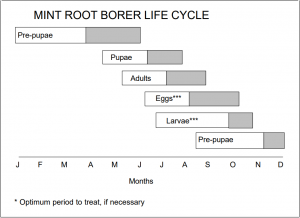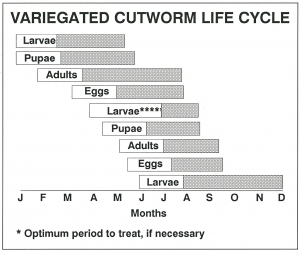This site will serve as a central resource for the Mint Pest Alert eNewsletter, which will be delivered from June through August with insect development information in the form of growing degree-day models. This information should be used in conjunction with samples collected from your fields to maximize efficacy of insecticide applications if they are needed. The purpose of this newsletter is not to recommend an application be made in your fields, but to alert you to the development of these populations statewide. Populations of both Mint Root Borer (MRB) and Variegated Cutworm (VC) are not identical among or within growing regions, and the information in these pest alerts in no way confirms the presence or absence of treatable populations in your fields. Specific application timing recommendations will be given with respect to the use of Coragen, but the insect development information will also be useful for the traditional approach of using Orthene or Lorsban.
What are degree-day models?
Degree-day models are based on rate of an insect’s growth at different temperatures. Insects have development threshold temperatures (e.g. 50°F for MRB), and only temperatures above this threshold result in growth. Because a specific amount of time spent above that temperature (called degree-days) is needed for an insect to complete development, the accumulation of these heat-units can be used to both track and predict insect growth. Degree-day models use both observed and predicted temperatures to calculate degree-day accumulation.
Insect life cycles
The e-Newsletter focuses on MRB and VC, but the recommended application timings will also control loopers and armyworms.
Mint root borer feed on underground mint rhizomes in the fall and can kill or seriously injure a stand. They overwinter as pre-pupae below the soil surface, and begin emergence as adult moths in June.
Moth wings vary from cream to chocolate-brown and are marked with darker lines. MRB moths are ~½” long and have enlarged labial palpi that look like a snout. Eggs are laid on leaf surfaces and hatch within 5-10 days. Early instar larvae feed on the leaves briefly and then drop to the soil and tunnel into rhizomes where they can feed through October. In-season control (eg. Coragen) targets the pest before it drops to the ground.
Variegated cutworm feed on foliage and can be extremely destructive when populations are high. Cutworms overwinter as partially mature larvae, begin feeding in early spring, and then mature and pupate in April/May. Adult moths emerge in May/early June and deposit eggs on the underside of leaves. Adult moths are large and brown to reddish-brown with dark spots on the wings. Eggs hatch in 4-7 days and larvae feed on foliage for 4-6 weeks before dropping to the ground to pupate. Mature larvae are up to 1.5” long and are a mottled color with a yellow band along the side. If treatment threshold is reached, larvae should be controlled before they start feeding heavily in the 4th instar.
Coragen is an effective, narrow-spectrum insecticide for control of several pests on peppermint. Application timing for MRB and VC is based on degree-day insect development models to increase precision for maximum control. Timing is similar to in-season Orthene application for Cutworms, but differs from the traditional fall application of Lorsban for Mint Root Borer (MRB).
Control eggs and early instar larvae before damage occurs Control multiple insect pests with single application
- MRB, Cutworm, Armyworm, Loopers
Environmentally Friendly:
- Extremely low application rates (3.5 – 7.5 oz/acre)
- 2 week residual control
- Translaminar movement through leaf tissue
- Control eggs & larvae feeding on both top and bottom of leaves
- Selective activity on caterpillars and some sap-feeding pests
- Easy on beneficial insects
- 4 hour REI
Application Timing:
Based on degree-day insect development models for MRB and VC
Research on MRB indicates:
- Application window of 10-14 days from peak flight to peak egg-laying
- Target peak flight for most consistent control of MRB
- Peak flight provides best control of both MRB and Cutworms with single application
- Post-harvest control has been less effective than earlier application timings


